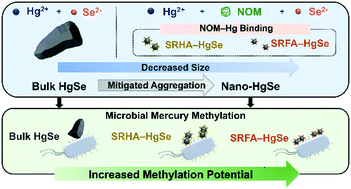Natural organic matter facilitates formation and microbial methylation of mercury selenide nanoparticles†
Abstract
Due to their extremely low solubility, mercury selenide (HgSe) minerals are long considered as environmental sinks of mercury that pose minimal risks to ecological systems. Thus, selenium amendments have been widely applied in agricultural soils to mitigate mercury contamination and produce Se-rich crops. Here, we demonstrate that co-precipitation of ubiquitous natural organic matter (NOM), divalent mercury and selenium leads to the formation of nanoscale tiemannite (HgSe) particles, which are rapidly converted into bioaccumulative neurotoxin, methylmercury, upon exposure to methylating bacteria. The methylation potential of these tiemannite nanoparticles decreases during aging and yet remains to be significantly greater than that of bulk-HgSe formed in the absence of NOM. Nano-tiemannite formed with fulvic acid appears to be smaller in size and more available for methylation, compared with nano-tiemannite formed with humic acid. This trend may be explained by the different extents of chemical binding, likely through inner-sphere coordination between surface mercury atoms of HgSe and NOM carboxyl moieties. Our findings point out the potential risks to food safety by the application of mercury–selenium antagonism in agricultural practices, and add new perspectives to understanding the occurrence and impact of an emerging group of mercury species, mercury-containing nanominerals, that may substantially contribute to mercury biogeochemistry.

- This article is part of the themed collection: Urgent communications in RSC Environmental Science journals


 Please wait while we load your content...
Please wait while we load your content...